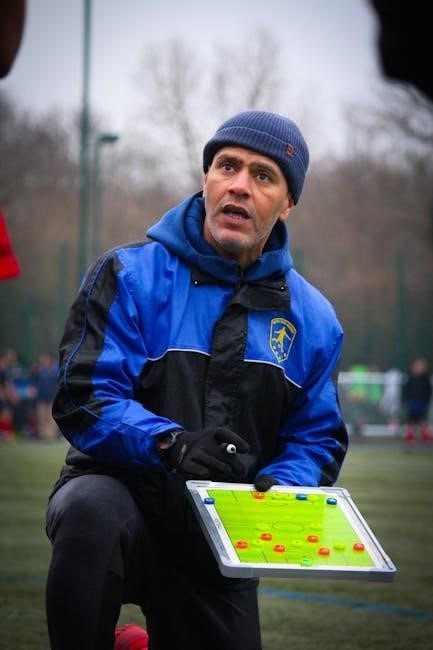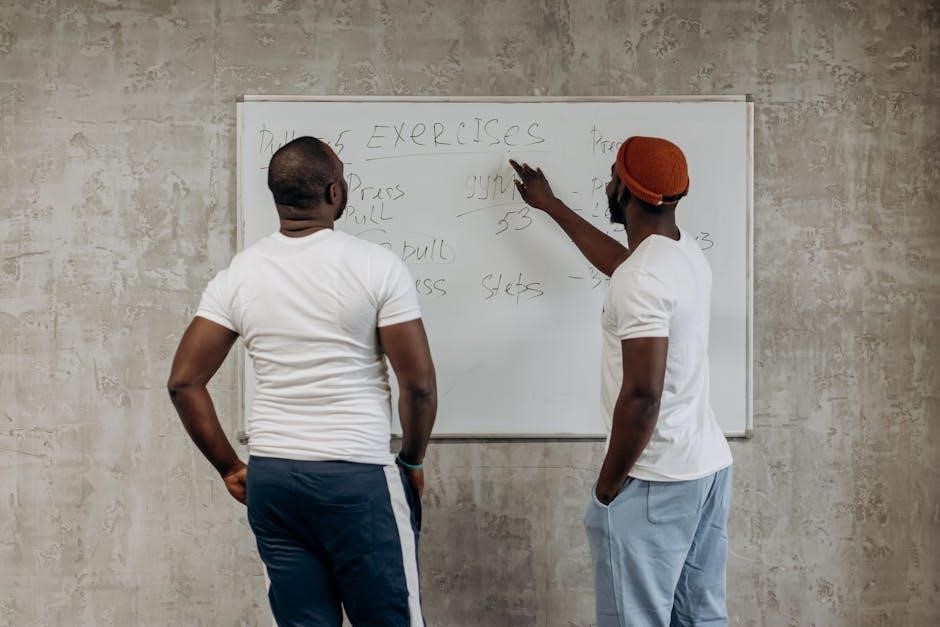The Royal Marines Training Plan is a structured, progressive program designed to prepare recruits for the demands of becoming an elite commando. It outlines a detailed 12-week schedule, focusing on physical fitness, mental resilience, and tactical skills. The plan is divided into phases, each building on the previous one, ensuring a gradual increase in intensity and complexity. This comprehensive guide is essential for anyone aiming to meet the rigorous standards of the Royal Marines, providing a clear roadmap to achieve peak physical condition and operational readiness.

1.1 Overview of the Royal Marines Training Program
The Royal Marines Training Program is a rigorous and comprehensive 12-week course designed to transform recruits into elite commandos. It begins with the Recruit Orientation Phase (ROP), followed by Initial Training Phase 1 and the Physical Training Foundation Module. The program focuses on building physical fitness, mental resilience, and tactical proficiency through structured exercises and assessments. Recruits undergo progressive physical training, including runs, strength exercises, and load carries, with intensity increasing over time. The program also emphasizes teamwork, leadership, and weapons training, ensuring recruits meet the high standards required for Royal Marines service. The training is conducted at the Commando Training Centre Royal Marines (CTCRM), where instructors guide recruits through each phase, ensuring they develop the skills and mindset needed for operational success.
1.2 Importance of the Training Plan PDF
The Royal Marines Training Plan PDF is a vital resource for recruits, providing a detailed roadmap to prepare for the demanding 12-week program. It outlines daily activities, exercises, and assessments, ensuring recruits understand expectations and can track progress. The PDF includes structured schedules, fitness benchmarks, and nutritional advice, offering a holistic approach to preparation. By following the plan, recruits can build the physical and mental resilience required for the rigorous training ahead. The document also serves as a motivational tool, helping individuals stay disciplined and focused on their goal of becoming a Royal Marine. Its clarity and comprehensiveness make it an indispensable guide for achieving the high standards of the Royal Marines.

Phases of Royal Marines Training
The Royal Marines training is divided into distinct phases, including the Recruit Orientation Phase (ROP), Initial Training Phase 1, and the Physical Training Foundation Module. Each phase builds progressively, ensuring recruits develop the necessary skills and resilience to meet the elite standards of the Royal Marines.
2.1 Recruit Orientation Phase (ROP)
The Recruit Orientation Phase (ROP) is the initial stage of Royal Marines training, designed to prepare recruits physically and mentally. This four-week phase introduces recruits to the rigorous standards of the Royal Marines, focusing on foundational skills and resilience. ROP includes sub-maximal physical training, targeted coaching, and mentoring to ease recruits into the demanding environment of Commando Training Centre Royal Marines (CTCRM). The phase emphasizes teamwork, discipline, and adaptability, setting the foundation for the challenges ahead. By the end of ROP, recruits are expected to demonstrate improved physical fitness and mental toughness, ready to progress to the next phase of their training.
2.2 Initial Training Phase 1
Initial Training Phase 1 is a 16-week program that builds on the foundation established during the Recruit Orientation Phase (ROP). This phase introduces recruits to the core skills required to become a Royal Marine, including advanced physical fitness, fieldcraft, and weapons training. Recruits engage in rigorous exercises such as load carries, obstacle courses, and close combat drills. The phase also emphasizes teamwork, leadership, and mental resilience through challenging scenarios. By the end of this phase, recruits are expected to demonstrate significant improvements in both physical and mental capabilities. The culmination of Phase 1 includes assessments that test their readiness to progress to more advanced training, ensuring they meet the high standards of the Royal Marines.
2.3 Physical Training Foundation Module
The Physical Training Foundation Module is a critical component of the Royal Marines Training Plan, focusing on building a robust physical foundation. This module introduces recruits to essential exercises and conditioning techniques, such as strength training, endurance runs, and core stability workouts. The program is designed to progressively increase intensity, ensuring recruits adapt and improve over time. Key activities include load carries, bodyweight circuits, and swimming, which are vital for developing the stamina and agility required for commando operations. By mastering these foundational skills, recruits establish a solid base for more advanced physical challenges in subsequent phases of training, aligning with the Royal Marines’ emphasis on peak physical condition.

Physical Training Requirements
The Royal Marines Training Plan outlines rigorous physical requirements, including the RMFA, progressive exercises, and a structured program to build endurance, strength, and core stability.
3.1 Royal Marines Fitness Assessment (RMFA)
The Royal Marines Fitness Assessment (RMFA) is a critical evaluation tool used to measure recruits’ physical readiness. It includes a series of standardized tests such as runs, pull-ups, press-ups, sit-ups, and deadlifts. These assessments are designed to evaluate cardiovascular endurance, muscular strength, and core stability. Conducted at the start of each training block, the RMFA ensures recruits meet the minimum fitness standards required for progression. The results help instructors tailor training programs to address individual weaknesses and improve overall performance. Achieving a high score on the RMFA is essential for advancing through the rigorous Royal Marines training program successfully.
3.2 Progressive Physical Training Programme
The Progressive Physical Training Programme is a cornerstone of the Royal Marines’ preparation, ensuring a steady increase in physical demands. Structured over 12 weeks, it is divided into three building blocks, each escalating in intensity and duration. The program incorporates runs, strength training, core exercises, and load carries, designed to enhance endurance, power, and overall fitness. Recruits are assessed at the start of each block to monitor progress and ensure they meet the required standards. This structured approach allows for gradual adaptation, reducing injury risks while building the resilience needed for elite commando operations. The program’s progression aligns with the Royal Marines’ operational demands, ensuring peak physical condition for real-world challenges.
3.3 Key Exercises and Tests
The Royal Marines Training Plan includes a series of key exercises and tests to evaluate physical and mental readiness. The Royal Marines Fitness Assessment (RMFA) is a critical component, featuring pull-ups, press-ups, sit-ups, and a 1.5-mile run. Recruits also undergo load-carrying exercises, endurance tests, and swimming assessments to ensure versatility. Specific tests like the “Bottom Field” and “Tarzan Assault Course” push recruits to their limits, simulating operational challenges. These exercises are designed to build strength, agility, and stamina, while also assessing mental toughness. The program culminates in a final fitness test to confirm readiness for commando operations. Regular evaluations ensure recruits meet the elite standards required for Royal Marines service, preparing them for the demands of real-world missions.

Mental and Tactical Preparation

Mental and tactical preparation in the Royal Marines involves resilience training, advanced tactics, and leadership exercises to equip recruits for high-pressure operational environments.
4.1 Mental Resilience Training
Mental resilience training is a cornerstone of the Royal Marines program, fostering psychological strength to handle stress and adversity. Techniques include mindfulness, stress management, and confidence-building exercises. Recruits learn to maintain focus under pressure, adapt to unpredictable situations, and develop a growth mindset. Instructors use targeted coaching and mentoring to enhance mental toughness, ensuring recruits can perform in high-stakes environments. This training prepares individuals to overcome challenges, both during and after their service, by building mental fortitude and emotional stability. The program integrates real-life scenarios to simulate operational pressures, ensuring recruits are mentally equipped for the demands of modern commando operations.
4.2 Weapons and Tactics Training
Weapons and Tactics Training equips Royal Marines with essential combat skills, focusing on weapon handling, tactical maneuvers, and real-world scenarios. Recruits learn to operate various firearms, including rifles and machine guns, with precision and safety. The training emphasizes teamwork, situational awareness, and decision-making under pressure. Tactical drills simulate urban and field environments, preparing recruits for diverse operational settings. Instructors provide expert guidance, ensuring proficiency in both individual and group tactics. This module builds on foundational skills, progressing from basic weapon handling to advanced combat strategies. The goal is to develop adaptable, confident, and effective warriors capable of excelling in modern combat situations.
4.3 Teamwork and Leadership Development
Teamwork and leadership development are cornerstone elements of the Royal Marines Training Plan, fostering unity and command capabilities among recruits. Through collaborative exercises and shared challenges, individuals learn to rely on each other, building trust and cohesion. Leadership skills are cultivated through rotational command roles, where recruits practice decision-making and guiding their peers. Instructors emphasize communication, problem-solving, and adaptability, preparing future Marines to lead effectively in high-stress environments. The training environment encourages a culture of mutual support, ensuring that every recruit understands their role within the team and can step up to lead when required. This module transforms individuals into confident, capable leaders who embody the Royal Marines’ values of courage, determination, and teamwork.

Training Environment and Facilities
The Royal Marines Commando Training Centre (CTCRM) at Lympstone provides state-of-the-art facilities, including obstacle courses, shooting ranges, and swimming pools. Instructors create a challenging yet supportive environment.
5.1 Commando Training Centre Royal Marines (CTCRM)
The Commando Training Centre Royal Marines (CTCRM) in Lympstone is the premier facility for Royal Marines training, renowned for its rigorous and comprehensive programs. Equipped with cutting-edge infrastructure, it includes obstacle courses, firing ranges, and state-of-the-art training areas that simulate real-world scenarios. The centre is designed to push recruits to their limits, ensuring they develop the physical, mental, and tactical skills required for modern commando operations. Experienced instructors provide expert guidance, fostering a culture of resilience and excellence. CTCRM is not just a training ground but a symbol of the Royal Marines’ commitment to producing elite commandos capable of thriving in the most challenging environments. The facility’s unique setup ensures recruits are fully prepared for the demands of service.
5.2 Role of Instructors and Mentors
Instructors and mentors play a pivotal role in the Royal Marines training process, providing expert guidance and support to recruits. They are highly experienced professionals who have undergone rigorous training themselves, enabling them to impart valuable knowledge and skills. Their primary focus is on developing recruits’ physical, mental, and tactical abilities while fostering a culture of resilience and teamwork. Mentors often share their real-world experiences, offering insights that prepare recruits for operational challenges. By creating a supportive yet demanding environment, instructors ensure that trainees meet the high standards expected of Royal Marines. Their leadership and dedication are instrumental in shaping the next generation of commandos, helping them overcome obstacles and achieve their full potential. This mentorship is crucial for building confidence and competence throughout the training journey.

Nutrition and Recovery Strategies
Nutrition and recovery are vital for optimal performance. The plan emphasizes balanced diets, hydration, and recovery techniques like stretching and sleep to enhance physical and mental rejuvenation.
6.1 Importance of Proper Nutrition
Proper nutrition is essential for maximizing performance and recovery during Royal Marines training. A balanced diet ensures energy levels are sustained, supporting intense physical and mental demands. Adequate intake of proteins, carbohydrates, and fats fuels muscle growth, endurance, and recovery. Hydration is critical to prevent fatigue and maintain focus. The training plan emphasizes tailoring nutrition to individual needs, ensuring recruits can meet the rigorous standards. Poor nutrition can lead to underperformance and increased injury risk. By prioritizing nutrient-rich meals and timely eating, recruits can optimize their bodies for the challenges ahead, both in training and operational environments. Proper nutrition is a cornerstone of success in the Royal Marines.
6.2 Recovery Techniques for Optimal Performance
Recovery is a critical component of the Royal Marines Training Plan, ensuring recruits can maintain the intensity required for demanding physical and mental challenges. Techniques such as stretching, foam rolling, and hydration help reduce muscle soreness and improve flexibility. Sleep is emphasized as a key recovery tool, with recommendations for 7-9 hours per night to aid muscle repair and cognitive function. Additionally, active recovery methods like light swimming or cycling promote blood flow without overexertion. Proper recovery strategies prevent overtraining, reduce injury risk, and enhance overall performance. By incorporating these techniques, recruits can optimize their bodies for the next day’s training, maintaining peak readiness throughout the program.

Progressive Training Programme Details
The Royal Marines Training Plan outlines a 12-week progressive program, focusing on physical and mental development through structured phases, gradually increasing intensity and duration to build resilience and readiness.

7.1 12-Week Training Structure
The 12-week training structure is divided into three distinct building blocks, each lasting four weeks. The first block focuses on foundational fitness, incorporating strength, endurance, and mobility exercises. Weeks 1-4 emphasize basic conditioning, including pull-ups, press-ups, sit-ups, and short-distance runs. The second block (weeks 5-8) introduces more advanced circuits and longer runs, while increasing the intensity of strength training. The final block (weeks 9-12) pushes recruits to their limits, with high-intensity interval training, load carries, and simulated operational scenarios. This gradual progression ensures recruits build resilience and adapt to the demands of Royal Marines training.
7.2 Building Blocks of the Programme
The Royal Marines Training Plan is structured into three building blocks, each designed to progressively increase fitness and skill levels. The first block focuses on foundational strength, endurance, and mobility through exercises like pull-ups, press-ups, and short runs. The second block intensifies training with advanced circuits, longer runs, and heavier lifts, while introducing tactical drills. The final block prepares recruits for operational demands, incorporating load carries, simulated missions, and high-intensity interval training. Each block is carefully calibrated to ensure continuous improvement, building both physical and mental resilience. This incremental approach ensures recruits are fully prepared for the challenges of Royal Marines service by the end of the 12-week program.
7.3 Weekly Activity Schedule
The Royal Marines Training Plan outlines a detailed weekly activity schedule, ensuring a balanced and progressive approach to physical and tactical development. Each week is divided into structured sessions, focusing on strength training, endurance runs, and functional exercises. Mondays and Thursdays typically emphasize upper body strength and core workouts, while Tuesdays and Fridays focus on aerobic endurance and agility drills. Wednesdays are reserved for load-carrying exercises and tactical simulations, mimicking real-world scenarios. Weekends include long-distance runs and team-based activities to foster camaraderie and leadership. The schedule also incorporates rest and recovery days to prevent overtraining. This structured approach ensures recruits build stamina, strength, and tactical proficiency systematically, aligning with the program’s 12-week progression.
The Royal Marines Training Plan PDF is a comprehensive guide to achieving peak physical and mental readiness. It ensures recruits meet the elite standards required for operational success.
8.1 Significance of the Training Plan
The Royal Marines Training Plan holds immense significance as it prepares recruits for the elite standards of the Royal Marines. This structured program ensures progressive development of physical fitness, mental resilience, and tactical skills. By following the 12-week plan, individuals build the necessary adaptability and resilience to operate in challenging environments. The plan’s emphasis on a balanced approach to fitness, nutrition, and recovery guarantees peak readiness. It serves as a roadmap for recruits to achieve the high levels of performance expected of Royal Marines Commandos, ensuring they are prepared for the demands of modern military operations and can effectively serve in various global scenarios.
8.2 How to Access the Royal Marines Training Plan PDF
The Royal Marines Training Plan PDF is accessible through various official and reputable sources. The primary source is the Royal Marines official website, where the document is available for download. Additionally, it can be found on military fitness and training platforms, such as the Boot Camp Military Fitness Institute and other educational repositories like MIT OpenCourseWare. To ensure authenticity, verify the source’s credibility before downloading. Simply search for “Royal Marines Training Plan PDF” on these platforms and follow the provided links to access the document. Always opt for the most recent version to align with current training standards and guidelines.
